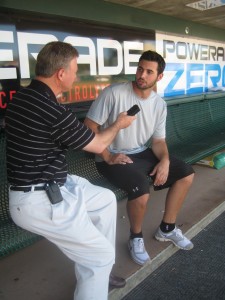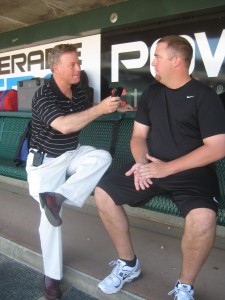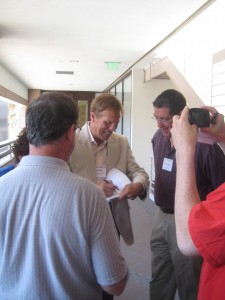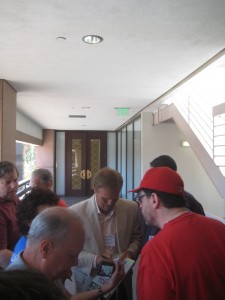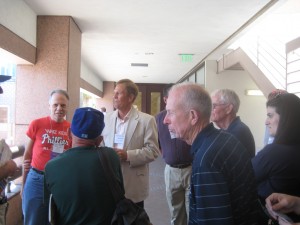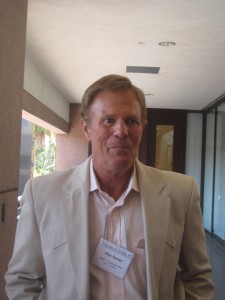Wes Parker played first base for the Dodgers from 1964 – 1972, so he’s used to being on the receiving end of things. Last week in Long Beach, Parker received accolades from adoring fans and enthusiastic members of SABR – the Society for American Baseball Research. Society for American Baseball Research
More than four hundred were on hand for SABR’s national convention.
Parker held court at the Long Beach Hilton, where dozens of baseball enthusiasts surrounded him for autographs and waited patiently for inside stories about the Dodgers.
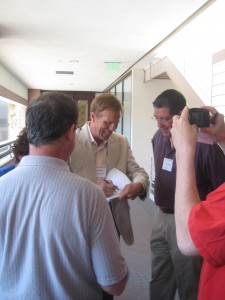
Wes was funny, entertaining and still very passionate about the game of baseball – a game in which he excelled in the field, winning six consecutive Gold Glove awards from 1967 – 1972. In his day, Parker could easily handle anything thrown his way, so I decided to toss him a few curve balls.
“Wes you played for one of the most storied franchises in all of baseball. And as you look at the Dodgers today, what are your thoughts?” I asked the former first baseman.
“Oh it’s killing me,” he stated. “I can’t tell you what I feel because I still work for the Dodgers. But it’s….”
And then Parker paused. For 12 seconds there was dead silence that said everything.
“It’s very disappointing, I will say,” he continued.
“Peter O’Malley, who never says anything bad about anybody – remember about 4 months ago in the L.A. Times, he came out with a statement saying, ‘It’s time for Frank McCourt to leave. He’s lost the faith of the city and the ballclub. It’s bad for this team’.
“We’re down 7,000 fans a game,” Parker lamented. “That’s over half a million people a year.”
“So what do the Dodgers need to do to get that magic again?” I asked.
“Well they have McCourt,” Parker responded. “I can’t really say (more) because it could go on the air and I work for the Dodgers.” (Since 2009, Parker has served as a representative of the Dodgers Legend Bureau.)
I nodded my head, then moved on to another topic – one that I thought might allow the Dodger great to hit one out of the park.
“Let me ask you about one of your former teammates,” I said.
“Maury Wills – he did not make the Hall of Fame,” I noted, “But a lot of people think Maury Wills should have made it in. What are your thoughts?”
“He’s deserving,” Parker asserted.
But other guys should also be enshrined in Cooperstown, Parker stated – guys like Johnny Callison of the Phillies, Kenny Boyer of the Cardinals, Ron Santo of the Cubs and the Dodgers very own Gil Hodges.
But Parker saved his biggest praise for an opponent he faced in the 1965 World Series.
“Tony Oliva – great player!” Parker exclaimed. He seemed in awe of the three time batting champ from the Minnesota Twins.
“If you saw Tony Oliva before his knees ran out, he was as good as anybody. Like a Clemente but a lefthanded hitter. In fact, he was a Rod Carew with power – same type of hitter with power. Great ballplayer, great arm, good outfielder.”
“Who are some of the players today that you think are the most exciting to watch?” I wanted to know.
“I like Derek Jeter,” Parker said. “Matt Kemp is becoming like that – he’s got great skills. He reminds me of Dave Winfield. And the pitcher for Detroit – Verlander – God what electric stuff he’s got. Great pitcher – as is the left hander with the Phillies – Lee has great stuff, overpowering. Strasburg was fun to watch (before he got injured). Anybody that throws 100 is fun to watch.”
Parker was one of the finest first basemen in all of baseball – but Parker told the crowd of another Dodger who struggled in the field. His name was Steve Garvey.
“Steve came up as a third baseman before Ron Cey,” Parker noted. “But he made more errors than any third baseman ever. I think his fielding percentage at third base was the lowest maybe in history because he couldn’t throw the ball straight. And he had very little range.”
However, Garvey could hit. So after Parker retired in 1972, Dodger manager Walter Alston had to find a spot for Garvey in the lineup, to take advantage of his bat. Parker recalled Alston saying, “I can’t put him at third. He’s proven he can’t play there. Plus we have Ron Cey now. So I’m going to try him at first base.”
And it worked Parker stated, “because it hid his two major flaws – not completely, but mostly. But he had good hands. He could catch, throw and he could scoop balls out of the dirt.”
Ironically, Steve Garvey was fired by the Dodgers the day after Parker made his comments. The timing was purely coincidental – but the club terminated Garvey from his community relations job after trying to rescue the Dodgers – by buying them from Frank McCourt. But as Garvey learned the hard way, the Dodgers are not for sale – at least not yet.
Talk about a brushback pitch.
“Who were the toughest pitchers you faced in your career?” I asked Parker, a lifetime .267 hitter.
“Jim Maloney was so underrated,” he stated.
Maloney pitched for the Cincinnati Reds from 1960 -71, with a lifetime record of 134-84.
“He threw 100 miles per hour,” Parker told me. “He pitched two no-hitters and if he hadn’t hurt his arm, he’d be in the Hall of Fame.
“Marichal was the smartest pitcher, ” Parker said emphatically. “The smartest because of his ability to throw to a hitter’s weaknesses. Like if I was looking for an outside pitch, it was like he was living in my brain. He could see it by the position of my feet or how I strode into the pitch. The next pitch would be BOOM – right in here,” he said pointing to his ribs.
“I played against Warren Spahn,” he added, noting that Spahn was also a very smart pitcher. “And James Rodney (JR) Richard (of the Astros) would be in the Hall of Fame if he hadn’t hurt his arm. Great pitcher.”
“Aren’t you glad you didn’t have to face Drysdale and Koufax?” I asked Parker.
“Yeah I never did, you’re right.” But in the ’60s he noted, “we were looking at two Hall of Fame pitchers every series. Because the Mets had Seaver and Nolan Ryan. They also had Jerry Koosman, Tug McGraw. God these guys were good.”
Parker was on a roll now. “The Cardinals had Steve Carlton and Bob Gibson. The Dodgers – we had Drysdale, Koufax and Sutton – that’s three. The Phillies had Bunning and Chris Short, who’s another one who’s close.”
And of course the Giants he noted, had Hoyt Wilhelm, Juan Marichal and Gaylord Perry.
“Every night you knew you had to come out there with your best attention, your best energy, your best effort – because no matter who was on the mound against you – they were going to be great.”
“The one guy I could hit was Bob Henley with the Giants,” Parker said. “And Ray Sadecki. God I hit Sadecki,” he laughed.
“He’d try and hook the outside corner with a curve. His fastball was straight, no movement. But if he saw you looking for it, he’d throw this big sweeping curve and try and hook the outside corner – because you’d see it way out there and say – that’s not a strike! But it would come back three feet. The umpire would call it a strike.”
But Parker quickly mastered Sadecki’s big sweeping curve ball.
“Well once I caught on to all that stuff, he couldn’t get me out,” he said with a smile, as the crowd roared its approval.
In 1972, Major League Baseball shut down for 13 days in the first ever player strike. And guess who the Dodgers’ player rep was at the time? None other than Wes Parker – in a role he never relished. Tomorrow night, I’ll give you the inside story of the ’72 baseball strike – from the only player rep who voted No!

